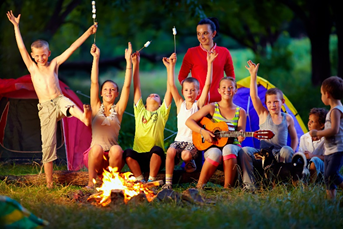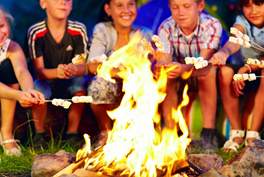It seems as if the best parts of summer camp start with the letter ‘S.’ Swimming, smores, sharing, sleeping bags, and sunsets are all an integral part of the summer camp experience. Campfire Storytelling also plays a special role in their ability to captivate, transport, and teach.
Which leads to an important question—what makes summer campfire stories so unique? And how do storytelling masters craft the stories that are told and re-told? The following eight tips are sure-fire ways to keep your listeners on the edge of their seats.

Storytelling Tip #1: Choose a Story That You Like (with a Lesson)
A great storyteller knows that a story has to have elements of suspense and challenge, the characters need to be relatable, and the resolution of the problem ideally should provide a lesson that the listener can remember and incorporate. The storyteller has to relish telling it, so picking the right material is the first step. How? The easiest route is to read several stories and select one that ‘speaks’ to you. If a story is boring to you, it won’t be exciting summer camp entertainment. If you feel that a tale is hard to follow, the children will probably get distracted while listening as well.

Telling a story isn’t just about entertaining, though. As part of a strong summer camp leadership team, you have the opportunity to share bits of wisdom with the kids you’ll meet. We’re all programmed to learn best through stories. They’re repeatable and build resiliency.
Here’s a great example of a Native American story often used for summer camp entertainment. It’s called the Buffalo and the Field Mouse. The ‘real’ tale is a bit longer, but we’ve shortened for the article’s sake. Notice how the characters are relatable; the story has an arc set up, conflict, resolution, and moral: and it has a great lesson in how letting your anger and desire for winning at all costs can hurt everyone.
Long, long ago, while a field mouse was out gathering some beans to store for the winter, his neighbor, a buffalo, came to graze in the meadow. Field Mouse hated when Buffalo ate close to him because Buffalo’s long tongue and heavy feet always mowed down the grass, making it hard for Field Mouse to find a place to hide or food to eat. Finally one day, Field Mouse became so angry, he challenged Buffalo to a fight.
Now Buffalo didn’t pay any attention to the little rodent at first. He thought Field Mouse was only joking! Which just made Field Mouse angrier. He rechallenged the beast, this time yelling louder and louder until he could no longer be ignored.
“Be quiet, Little pest,” Buffalo finally replied, “Otherwise I will come over there and step on you.”
“Not possible!” the angry mouse replied. “I DARE you” he continued, provoking Buffalo more and more.
Now angry himself, Buffalo rushed toward Mouse, trampling everything in his path. In his anger, he didn’t realize that Mouse had climbed into his ear. The gnawing inside drove Buffalo crazy, causing him to stomp not only all of the meadow grass but also the beans. He knocked down trees and trampled fruit bushes as well.
When the mouse finally came out of Buffalo’s ear laughing and triumphant, he was shocked at what he found. Although he had won the fight, the entire meadow was destroyed. In the end, both animals would have a tough time surviving the winter with nothing to eat.
After telling the story, you could talk to the campers about the lesson that they might learn from Field Mouse and Buffalo like that selfishness leads to destruction or that working as a team is good for everyone.
After telling the story, you could talk to the campers about the lessons that they might learn from Field Mouse and Buffalo like that selfishness leads to destruction or that working as a team is good for everyone.
Storytelling Tip #2: Practice Makes Perfect
Close your eyes and think of your favorite story. Most likely, you heard it during your childhood. This is because as children, we are more open to the ideas of magic and mischief, fables and fairy dust. For thousands of years, people have been using stories to entertain, persuade, and even explain things in nature. Storytelling is an art. Art is always personal, but to be a great artist requires a few things—creativity, passion, and often, practice.
This first storytelling tip is the easiest of all—realize that practice makes perfect when it comes to anything you want to learn. Once you have your story, try:
- Practicing out loud
- Imagining how you might move or use hand movements to take on the characters in the story
- Reflect on your tone and how fast/slow you speak
Practice will allow you to find your ‘groove’ and improve your skills so that you can be the best storyteller at your camp.
Storytelling Tip #3: Embrace the Natural World
Because you’ll be telling your story in the wild, choosing one that has an outdoor theme or a nature-related lesson is a great way to tell a story that kids will relate to. This is why the tale of the buffalo and the mouse is an excellent choice to tell around a summer campfire.

You can craft a summer camp-themed campfire tell using camping vocabulary or find a story with a setting your campers can relate to. Examples include:
- Summer camp
- The zoo at night
- An alligator farm
- The beach
- A cabin in the woods
- A ranch or farm
Storytelling Tip #4: Hooking Your Listener
Tips 1-3 were mostly about making sure you are telling the true tale. Tips 4-8 will help you spin your storytelling web in the right way.
If you’ve ever taken any basic writing course, you know that “hooking your reader” is one of the first steps to writing a great story. The same can be said for oral storytelling.
As a guideline, experts suggest that a child’s age as a general starting point for the number of minutes they can stay focused. So for a ten-year-old, you have ten minutes, tops. But before we get to keep their attention, you have to gain it. To do this, you have to make them know more. Here are a few proven ways to hook your summer camp audience according to Conceptdrop:
- Use their imaginations. Having children close their eyes and imagine XYZ might seem a bit cliché, especially with older campers, but it works to engage imaginations and paint visuals that help engage the audience.
- Use props. Having actual objects to hold and let audience members see/smell/touch/feel while sitting around a summer campfire will help your tales feel ‘real.’ These don’t have to be expensive. Apples, sticks, whatever relates to your story, make sure you have something on hand.
- Interact with them. Stop and ask questions, include them in the process. This may mean that you change your tale up a bit as you go and that is okay. Keeping storytelling interactive will not only gain your listeners focus but also make them think.
- Play on their senses. This storytelling tip is so important that we made it number five!
Storytelling Tip #5: Infuse Sensory Info
As you tell a campfire story, you should work on getting in tune with your five senses.
- Sight
- Sound
- Hearing
- Touch
- Taste
When you are telling your tale, make sure to include as much sensory info as possible. Let’s look at our friends Field Mouse and Buffalo again. What kind of sensory info could we add in to make this short story even more interesting? Could we describe Field Mouse’s grey fur and beady eyes? Could we use sound words like “clomp, clomp” to help the campers envision Buffalo stampeding toward mouse? Including lots of sensory details will help you ‘show,’ not ‘tell.

Your campers should be able to see your campfire story characters in their mind just as they would if they had a storybook sitting in from of them.
Storytelling Tip #6: Keep Their Attention
If you’ve ever been fishing, then you know that getting the fish on the hook is just the first half of the battle. The second is keeping it there. The same will be true for your listeners. These tips can help:
- Keep it short and sweet. The only thing worse than a bad story is someone telling a good story but rambling during the process. Set a length for your campfire story and try to tell your tale in less time than what you’ve allotted.
- Don’t rush. Although you should set a max time for the telling of your story, you don’t want to rush through it. Pace yourself. Nervousness can make you feel as if you’re being driven by a motor. If you start to feel this way, slow it down.
- Pause periodically. One way to stop yourself from rushing is to pause regularly and look at your audience when you do. Amazingly, bits of silence woven into your story can help keep your campers attention even better than talking!
- Get them moving. Although most campfire stories are told with a sitting audience, it doesn’t have to be this way! Have them stomp like the buffalo or gnaw like the mouse. Having them use their bodies will keep them involved.
- Change when you need to. If something you’re doing isn’t working, change it up. Pull out that prop, ask a question, kick the dirt, see if a listener has a character they’d like to throw into the mix. Sometimes a story ‘jump-start’ is all you need to keep your summer campfire listeners engaged.
Storytelling Tip #7: Bring it Home through Emotion
If you’re telling a story about yourself, it should be just as much about how you felt as what happened. The same goes for campfire tales about characters. Human emotion is a powerful ‘hook’ and will help you bring your listeners to the finish line. Consider these questions:
- How did Field Mouse feel at the beginning of the story?
- How could we describe his anger? Were there other emotions at play?
- Maybe he was afraid of the thought of not having enough to eat or not being successful?
- What about Buffalo’s emotions? Does the end justify the means when it comes to the meadow being destroyed?
Include elements of suspense and drive empathy as well. These are thoughts and feelings your audience could surely relate to if you are crafty enough to web them into your story.
Storytelling Tip #8: Leave an Impact
Every storyteller wants three things: to entertain their audience, teach them something during the process, and for their story to be remembered. How you do this is up to you, but there are a couple of ways to make sure your tell isn’t forgotten.

One way is to have the listeners retell it! Go around the circle and have each listener tell a line of the story in the correct order. You could also have campers tell it to a partner, draw it out, or make up their sequel. What happens to Field Mouse and Buffalo next? Do they ever learn their lesson? Will they work together and survive the winter?
Handing your listeners the torch and have them carry the lessons they learned from your tale further is the best way of making sure that you accomplished your job as a master storyteller.
Now go on! Craft the perfect campfire story that you were always meant to tell!
